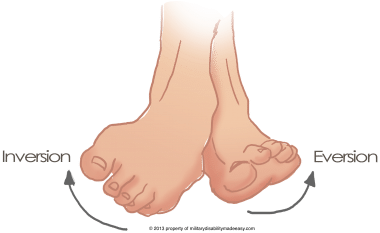
Ankle Joint
The ankle joint is important during walking/running/jumping/etc as it can adapt to the surface. The movement of this joint consists of inversion (bending inwards), eversion (bending outwards), plantarflexion (bending downwards) and dorsiflexion (bending upwards). Every joint in our body needs to be stabilised to prevent them from being dislocated. In our ankle, this stabilisation is provided by our ligaments and tendons which are located on the inside/outside ankle joint.
Ankle Sprain
An ankle sprain is a common injury that involves the damaging of the stabilising ligaments/tendons of the ankle. They occur when the ankle moves outside of its normal range of motion which can be seen mostly in active and sports populations. The severity of the damage can be differentiated into Grades which can be determined by our physiotherapists upon assessment.
Grade 1: stretching of tissue, no tear. Mild to moderate pain present
Grade 2: some tearing of connective tissue. Moderate to severe pain present
Grade 3: full thickness tear, surgery may be required. Severe pain may or may not be present
Types of Ankle Sprains

Inversion (Lateral) Ankle Sprain
- Most common form of ankle sprain. The ankle is rolled outwards while the foot turns inwards causing the ligaments located on the outside of the ankle to stretch or tear.
Eversion (Medial) Ankle Sprain
- The ankle is rolled inwards while the foot turns outwards resulting in the ligament located on the inside out the ankle to stretch or tear.
High Ankle Sprain (syndesmosis)
- Ankle is externally rotated excessively and dorsiflexed at the same time.
Symptoms:
- Pain while weight bearing on affected foot
- Swelling, bruising and redness
- Reduced range of motion
- Tenderness on touch of ankle
Management (what we can do at My Physio My Health for Ankle Sprains)
Our physiotherapists will assess the type, damage and severity of the ankle sprain to ensure our treatment plan is directly tailored to the patient.
RICE
In the early stages, we would aim to calm the pain and swelling first. Generally, we would apply the principles of RICE, which refers to Rest, Ice, Compression and Elevation. Our physiotherapists will guide you through each process that will be tailored towards your injury.
Massage
During the early stages of injury, swelling and stiffness will occur at the injury site. Therefore, our physiotherapists will be able to help massage and push the swelling away and reduce pain. At the same time, help reduce the stiffness of the irritated tissue, so that you can regain some movement that will help speed up the healing process.
Taping or strapping
When there is damage to the ligaments, taping or strapping may help stabilise your joints so that you can feel more supported and less pain at the same time not limiting too much of your movements as much as a brace would.
Braces
Depending on the stage or severity of the injury, a physiotherapist may prescribe appropriate equipment such as braces or supports to help lessen the pain and burden on the area injured until it heals.
Mobilisation of stiff joints
It is not uncommon for joints to go stiff when we move it less due to a variety of reasons like pain, injury or reduced body awareness. Therefore, our physiotherapist will be able to help find and loosen up any stiff joints to lessen pain, increase comfort and ensure optimal mechanics of your body. This will all in turn help prevent any future injuries or long-term damages.
Home-exercise programs
To help speed up healing and prevent future or recurring sprains and strains. A tailored exercise program will be provided to you which will be specific to your needs. This may include strengthening surrounding muscles, enhancing your proprioception (sense of body position) and improving your balance.
My Physio My Health
Trust our team of physiotherapists to help you recover faster and improve your quality of life.

 WISHING EVERYONE A HAPPY NEW YEAR! WE'VE RETURNED TO OUR REGULAR OPENING HOURS
WISHING EVERYONE A HAPPY NEW YEAR! WE'VE RETURNED TO OUR REGULAR OPENING HOURS



